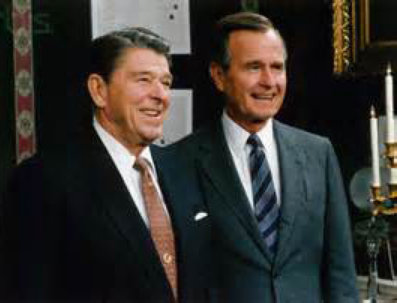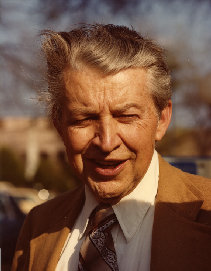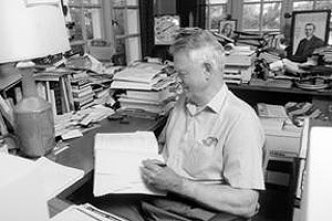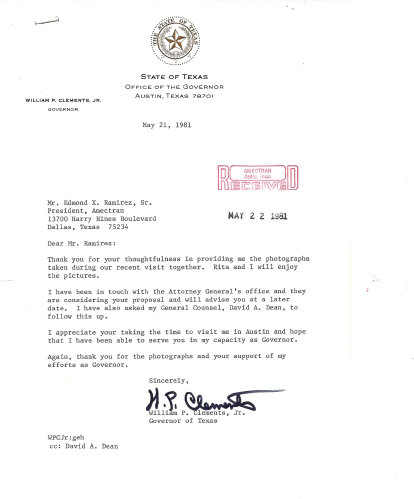The President Steps In
President Ronald Reagan was approached by various and sundry government agencies, their investigators and individuals
concerning problems Amectran Corporation and its CEO Edmond X. Ramirez Sr., were facing. Since the company was from Texas he askedVice President George H. W. Bush (who was from Texas), to contact Texas Governor William (Bill) P. Clements Jr. (see section below) in
order to facilitate a meeting with Amectranís CEO Ramirez. to see if the companyís problems with the State of Texas might
be resolved.
Ralph Abernathy was asked by President Reagan to attend the meeting between Governor Clements and Ramirez
to see that Ramirez was represented fairly and to present facts concerning years of investigations of Ramirez by both the U.S.
Department of Commerce and U.S. Department of Transportation in which investigations had determined that Amectran was being targeted
by both "known and unknown parties".
Congressman Byron Johnson was also asked by the President to attend the meeting as he had been following the
Amectran/Ramirez investigations as a result of his involvement with OMBE (Office of Minority Business Enterprise) and the desire by
Secretary of Commerce, Juanita M. Kreps, to fund an Amectran factory under UDAG (Urban Development Action Grant), a program for rural
areas. Farms were shutting down as a result of various problems including lack of rainfall, plant disease, low yield, market prices,
high cost of equipment, etc.
A factory in these areas would provide a yearly income for families and thereby stabilize the economy in that community. Young
people were leaving these communities in order to find steady employment, a factory employing a thousand people could easily
support such a farming community and Secretary Kreps saw jobs as a possible solution ... she was chastised for her effort
as Amectran became a problem for those 'known and unknown' enemies.
United States Secretary of Commerce Juanita M. Kreps* instigated an investigation of Amectran in order to determine
whether the company had the product it claimed and if it was viable for the project she had in mind for farming communities.
She assigned her Chief Investigator, Elliot W. Small Jr. After some eight months
Small and his team were exposed to several incidents of blatant violations by both government agencies and government supported organizations
who were aware of
Amectran and its advanced innovations proposed for the new electric automobile industry. Henry Ford II, Fordís CEO was adamant that electric automobiles would take years to even be considered for development and that technology could not be rushed, but must be allowed to evolve over the years. This contradiction to Amectran's proposal required close scrutiny.
February of 1981 Secretary Kreps was informed by the Small investigating team that an attempt to blow up the EXAR-1 prototype
in Los Angeles had taken place by three men. The act was thwarted by three Los Angeles police officers. Of the three assailants
one was captured, however no information concerning the other two or who hired the group was ever uncovered. As the result of that
attempt, Los Angeles Police officers decided to place the car at the L.A. Police Academy for its protection until its departure.
The three officers pictured here were responsible for the capture of one of the assailants and extinguishing the fire that threatened the destruction of the EXAR-1. Thereafter, they protected the EXAR-1, 24 hours a day 7 days a week, as well as during transportation to and from agendas where the car was to be tested and displayed. Unfortunately the last names of two of the officers have been misplaced over the years, left to right are officers Al, Sgt. Hal Moore and Arvin.
Mayor Gus Newport of Berkeley, California sponsored the effort to build an Amectran factory
in Berkeley, at 2:30A.M., September 5, 1980 after the parade honoring Amectranís successful testing of the EXAR-1
by the Federal Government, he received a warning that an attempt to discredit Amectran would appear in the San Francisco Chronicle
that morning. Mayor Newport was informed by an employee of the paper who reported he had seen a memo from General Motors directing
the paper to write a negative article by referring to the Federal case in
Mr. Small and his team investigated Amectran and Mr. Ramirez for over two years, including going to Italy to personally examine progress
on the EXAR-1 Electric Automobile as it was being constructed. During the two years of investigation, Small determined that there
was no question about the validity of the car project. It was also determined that Amectran was some 15 years ahead of any electric
car project in the world and that Amectran's innovations would change the automobile industry. Ford's projections were the
automobile industry's rational for any real interest in even considering an electric car program as the industry was already
in trouble from the Japanese auto makers. In 1980 American Motors was in financial trouble as a result of poor esthetic design;
Chrysler was facing slowing sales; General Motors was in trouble for trying to frame Ralph Nader for his
criticism of the Corvair - any proven electric car project was an added threat and financial problem to American auto makers.
In
a 1979 magazine article Ramirez predicted the failure of the American auto industry saying, "GM is the biggest culprit and they
will no doubt fail, while Chrysler is in the abyss: the American automobile industry - i.e., if the Japanese allow us to have
an American automobile industry at all - is in trouble and skeptics of something like the EXAR-1 will simply help its downfall.

Further, Small discovered that obstacles were constantly being placed in Amectranís way by the DOE and other outside influences
including pressure from the auto industry. He found that an Assistant Attorney General with the State of Texas, David Pace, was deeply
involved in attempting to put Amectran out of business in order, as it turned out, to cover-up his illegal activities. During his
investigation Small met with Dr. Carl C. Clark of the Department of Transportation to determine the viability of the project, only
to discover that Dr. Clark was equally aware of those efforts to shut down Amectran and Ramirezís electric
automobile
DOC investigator Elliot Small testing the EXAR-1 in Paris
project as it posed a substantial number of new innovations not welcomed by the automobile industry and others.
Dr. Carl C. Clark noted scientist (Inventor Contact Office of Passenger Vehicle Research, R&D National
Highway Traffic Safety Administration for the United States Department of Transportation), was also the scientist who was best known
for his pioneering efforts in the development of the automobile airbag. He had
personally become aware of attempts by Ed Brown, Assistant Director for Electric and Hybrid Vehicles, U.S. Department of Energy, to
discredit Amectran and Ramirez. Later, Dr. Clark was personally responsible for the successful testing of the EXAR-1, Amectranís electric
automobile as part of a Federal Court case brought by the U.S. Attorney Generalís Office and sponsored by Ed Brown of the DOE and
David Pace of the Texas State Attorney Generalís Office. This testing of the EXAR-1 was the third time Amectranís electric automobile
had been tested under Federal Government supervision, successfully passing every test required by the government and verifying Ramirezís
claims for the EXAR-1 performance: David Pace was shortly thereafter being investigated by the Texas AGís office for criminal misconduct
and was forced to resign.

which Amectran had just been embroiled Ė of course there was to be no mention that Amectran had won its case and testing by the Department of Transportation, under Federal Court proved its validity as a real electric car. The following morning, after the newspaper article appeared, and the local Berkeley paper blasted Amectran, an attorney acting as a reporter for Channel 2 television came to interview Ramirez. He spoke with various government officials, as well as representatives from several companies including COMSAT who was present to set up an appointment with Ramirez to discuss the possibility of a joint venture. After spending the day investigating Amectran, the attorney for the TV station realized that the negative newspaper articles were vastly unwaranted and broadcast a report of Amectran's credibility. Unfortunately it did not entirely negate the newspaper's unfavorable publicity and the Mayor's political opponents on the city council now took full advantage and now rejected the building of Amectran's factory.
Small had also reported the beating Ramirez sustained at the 1980 Chicago Automobile Trade Show, done in order to keep the car out
of the show. The attacker was none other than the son of the president of the show, Ross Kelsey. His son, who was head of
the showís security department, had removed his coat and tie and with others began the beating, however they were caught and
later identified by WGN TV. This action, as well as the other reports received by President Reagan prompted his
quick action (additional information concerning this incident can be found on the Site Map under section "Radio and TV Host Quits
While On Live Show Flies to Chicago to Help.")

Texas Governor William (Bill) P. Clements Jr., as a result of the Presidentís request through
Vice President Bush, to meet with Ramirez, Abernathy, Johnson, Small and receive calls from Clark and others during the meeting who
supplied information supporting the surreptitious actions being taken against Amectran took place on May 20, 1980. This information
along with certain reports from Congressman Johnson was responsible for the Governorís concern as to the treatment Mr. Ramirez
had received at the
the hands of the Texas State Assistant Attorney Generalís Mr. David Pace. The Governor had some trepidations
concerning what seemed to be taking place with Amectran and Ramirez so, as can be seen on the letter to the right, he decided
to have his own personal attorney "follow up " (meaning investigate the actions of David Pace): The Governor had
seen the letter Pace had sent to Ramirez's Attorney Dean Carlton (See below), and asked Ramirez, "Did Pace
expect you to turn your stock over to General Motors." [sic] - the problem was resolved in Mr. Ramirezís favor within 24
hours after discovery of Paceís improper activities in the case: later, Pace was under investigation for his criminal activities.

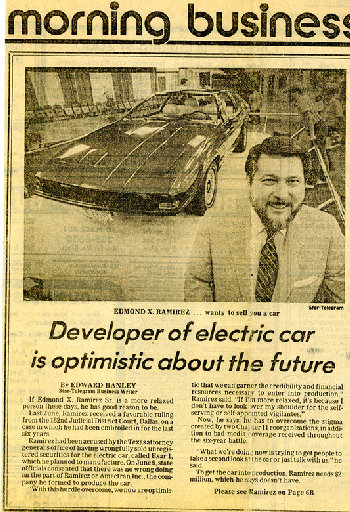

The U.S Secretary of Transportation, Brock Adams**, had introduced a program to ďReinvent the AutomobileĒ and Amectranís
EXAR-1 Electric Automobile had become an example of that reinvention program. At a Senatorial hearing in March of 1979 Secretary Adams
recommended the purchase of several Amectran Electric Automobiles for further government evaluation. Shortly
thereafter Secretary
Adams began receiving pressure from the automobile industry regarding his stance on Amectranís electric automobile project. The number
of advances proposed by Amectran would have caused the automobile industry to make considerable changes in production for automobile
safety. At the time the auto industry was fighting the use of seatbelts while Amectran was advocating the use of both seatbelts, as
well as that of Air Bags. As a result of the Secretaryís support of Amectranís advancements and ancillary and concomitant issues involved
with Amectranís introduction of innovative technology supporting the idea of ďreinventing the automobileĒ Secretary Adams was forced
to resign.
The U.S. Secretary of the Department of Agriculture, John R. Block was interested in funding Amectran factories in rural areas in
order to provide for employment to support the farming communityís; this was in line with Secretary Kreps rural initiative. Mr. Block
had obtained the services of a member of the U.S. Department of Energy to help him evaluate the Amectran project. At the final meeting
between Mr. Block, Congressman Johnson, Elliott Small and a representative from the Department of Energy advised Secretary Block that
the EXAR-1 was an exceptional electric automobile which was represented
*The above was a precis - for considerably more information concerning Secretary Kreps and the denouement of her support of the
Amectran Project see the Site Map - Government -
U.S. Secretary of Commerce, Recommends Funding for AMECTRAN...Is Forced to Resign.
accurately by Mr. Ramirezís claims. He also pointed out that he was personally aware of the animosity of certain DOE officials toward
Mr. Ramirez as a result of having issued a contract to Chrysler Corporation which should have rightfully gone to Ramirez. The DOE
representative also asked Secretary Block not to mention his name on the official report, in fear of possible repercussions from the
U.S. Department of Energyís Ed Brown.
When both Secretary Adams and Kreps were forced to resign; in consideration of that
denouement, Mr. Block felt it prudent to discontinue his proposed project with the Amectran before finding himself being forced
to resign in dealing with the influence of the automobile industry and their obvious ire over all the new innovations Amectran was
attempting to introduce.
The result of the Governors reading of the letter on the left and investigation of the case against Amectran and Ramirez, as well
as the State's Court actions perpertrated, prolonged and exacerbated by Pace were simply to provide him time to cover-up his
illegal actions.
Not surprising was the fact that only one local newspaper carried the news of vindication in the case of Amectran
and Ramirez - The Fort Worth Star Telegram. The 'Dallas Morning News' had always made it a point to print only damaging
news about Ramirez - news some of which was provided by Pace.
**The above was a precis - for considerably more information concerning Secretary Adams and the denouement of his support of
the Amectran Project see the Site Map - Government - U.S. Secretary of Transportation Testifies Before the U.S. Senate...




